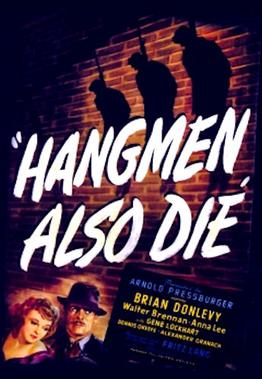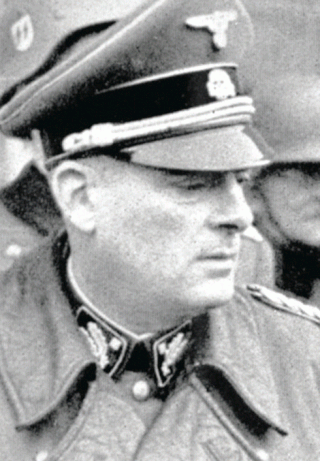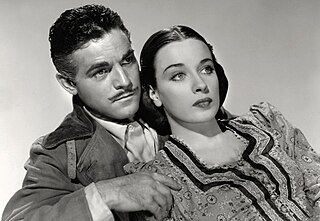
Reinhard Tristan Eugen Heydrich was a high-ranking German SS and police official during the Nazi era and a principal architect of the Holocaust.

The Lidice massacre was the complete destruction of the village of Lidice in the Protectorate of Bohemia and Moravia, which is now a part of the Czech Republic, in June 1942 on orders from Nazi leader Adolf Hitler and acting Reichsprotektor Kurt Daluege, successor to Reinhard Heydrich. It has gained historical attention as one of the most documented instances of German war crimes during the Second World War, particularly given the deliberate killing of children.

Reinhard Heydrich, the commander of the German Reich Security Main Office (RSHA), the acting governor of the Protectorate of Bohemia and Moravia and a principal architect of the Holocaust, was assassinated during the Second World War in a coordinated operation by the Czechoslovak resistance. The assassination attempt, code-named Operation Anthropoid, was carried out by resistance operatives Jozef Gabčík and Jan Kubiš on 27 May 1942. Heydrich was wounded in the attack and died of his wounds on 4 June.

Hangmen Also Die! is a 1943 war film directed by the Austrian director Fritz Lang and written by John Wexley from a story by Bertolt Brecht and Lang. The film stars Brian Donlevy, with Walter Brennan, Anna Lee, and Gene Lockhart, and Dennis O'Keefe in support. Alexander Granach has a showy role as a Gestapo detective, and Hans Heinrich von Twardowski has a cameo as Reinhard Heydrich. Hanns Eisler composed the Academy Award nominated score, and James Wong Howe was cinematographer.

Jan Kubiš was a Czech soldier, one of a team of Czechoslovak British-trained paratroopers sent to eliminate acting Reichsprotektor (Realm-Protector) of Bohemia and Moravia, SS-Obergruppenführer Reinhard Heydrich, in 1942 as part of Operation Anthropoid. During the attack, Kubiš threw the bomb that mortally wounded Heydrich.

Jozef Gabčík was a Slovak soldier in the Czechoslovak Army involved in the Operation Anthropoid, the assassination of acting Reichsprotektor (Realm-Protector) of Protectorate of Bohemia and Moravia, SS Obergruppenführer Reinhard Heydrich.

Ležáky, in the Miřetice municipality, was a village in Czechoslovakia. During the German occupation of Czechoslovakia, it was razed by Nazi forces as reprisal for Reich Protector Reinhard Heydrich's assassination in late spring 1942.

Atentát is a 1964 black-and-white Czechoslovak war film directed by Jiří Sequens. The World War II story depicts events before and after the assassination of top German leader Reinhard Heydrich in Prague. Czech historians have called the film the historically most accurate depiction of the events surrounding Operation Anthropoid.

Karel Čurda was a Czech Nazi collaborator during World War II.

František Moravec CBE was the chief Czechoslovak military intelligence officer before and during World War II. He moved to the United States after the war.

Operation Out Distance was a Czech resistance group active during World War II. It was dispatched by Special Group D of the Ministry of Defence of the Czechoslovak government in exile in London. The group operated in the Protectorate of Bohemia and Moravia, a region of occupied Czechoslovakia.

Czechoslovak resistance to the German occupation of the Protectorate of Bohemia and Moravia during World War II began after the occupation of the rest of Czechoslovakia and the formation of the protectorate on 15 March 1939. German policy deterred acts of resistance and annihilated organizations of resistance. In the early days of the war, the Czech population participated in boycotts of public transport and large-scale demonstrations. Later on, armed communist partisan groups participated in sabotage and skirmishes with German police forces. The most well-known act of resistance was the assassination of Reinhard Heydrich. Resistance culminated in the so-called Prague uprising of May 1945; with Allied armies approaching, about 30,000 Czechs seized weapons. Four days of bloody street fighting ensued before the Soviet Red Army entered the nearly liberated city.

Karl Freiherr von Fischer-Treuenfeld was a German Waffen-SS commander. A brigade commander during the Nazi era, during the invasion of the Soviet Union, he commanded the 2 SS Infantry Brigade and the 1 SS Infantry Brigade, which engaged in the killing of Jews, communists and partisans (bandits). Treuenfeld later commanded the SS Division Frundsberg. He committed suicide in 1946 whilst in American custody.

Hitler's Madman is a 1943 World War II drama directed by Douglas Sirk. It is a fictionalized account of the 1942 assassination of Nazi official Reinhard Heydrich and the resulting Lidice massacre, which the Germans committed as revenge. The film stars Patricia Morison and Alan Curtis and features John Carradine as Reinhard Heydrich. Sirk intended the film to function more as a documentary, but after Louis B. Mayer acquired the film in February 1943, he required reshoots to increase the drama. According to TCM, “Added material included Heydrich's deathbed scene with "Himmler" and university scenes featuring M-G-M starlets, including Ava Gardner.”

Anna Čalounová-Letenská was a Czech theatre and film actress. During the 1930s and 40s, she appeared in twenty-five films. She was murdered in the Nazi concentration camp of Mauthausen.

Josef Valčík was a Czechoslovak British-trained soldier and member of the Resistance in German-occupied Czechoslovakia who took part in the firefight during the aftermath of the assassination of Reinhard Heydrich by Jozef Gabčík and Jan Kubiš, code named Operation Anthropoid.

Anthropoid is a 2016 war film directed by Sean Ellis and starring Cillian Murphy, Jamie Dornan, Charlotte Le Bon, Anna Geislerová, Harry Lloyd, Toby Jones and Marcin Dorocinski, It was written by Ellis and Anthony Frewin. It tells the story of Operation Anthropoid, the World War II assassination of Reinhard Heydrich by exiled Czechoslovak soldiers Jozef Gabčík and Jan Kubiš on 27 May 1942. It was released on 12 August 2016 in the United States and 9 September 2016 in the United Kingdom.

The Man with the Iron Heart is a 2017 biographical action-thriller film directed by Cédric Jimenez and written by David Farr, Audrey Diwan, and Jimenez. An English-language French-Belgian production, it is based on French writer Laurent Binet's 2010 novel HHhH, and focuses on Operation Anthropoid, the assassination of Nazi leader Reinhard Heydrich in Prague during World War II.
Dramatic portrayals of Reinhard Heydrich number among the more numerous of any Second World War figure, comparable to Adolf Hitler as well as war films depicting Erwin Rommel. Reinhard Heydrich has been portrayed in both television and film, and was one of the few high ranking Nazis to be depicted in a dramatic film while the Second World War was still ongoing.

Lidice is a municipality and village in Kladno District in the Central Bohemian Region of the Czech Republic. It has about 600 inhabitants.



















